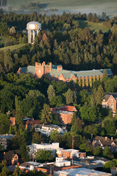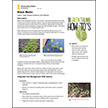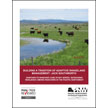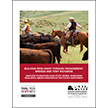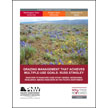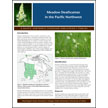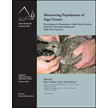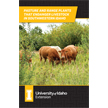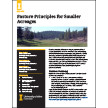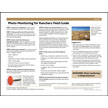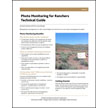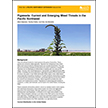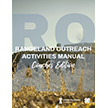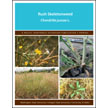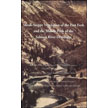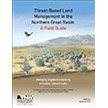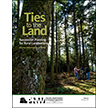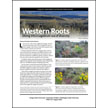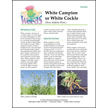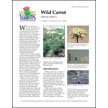Rangeland
Applying Adaptive Grazing Management
Grazing management requires flexibility to adapt to ever-changing climatic conditions, and changes in grazing management for public lands may be required because of endangered or threatened species.
Black medic ( Medicago lupulina ) is an annual or short-lived perennial from Eurasia. It can be found in lawns, pastures, rights-of-way and other marginal sites. Learn how to manage this...
This publication is part of the Rancher-to-Rancher Case Study Series: Increasing resilience among ranchers in the Pacific Northwest. Authors: Sonia A. Hall, Tipton D. Hudson, Georgine G. Yorgey, J.
This publication is part of the Rancher-to-Rancher Case Study Series: Increasing resilience among ranchers in the Pacific Northwest. Authors: Sonia A. Hall, Tipton D. Hudson, K. Scott Jensen, J.
Curlycup gumweed ( Grindelia squarrosa ) (Pursh) Dunal is native to North America except in the southeastern United States. This forb (herbaceous broadleaf plant) is commonly found along roadsides,...
This publication is part of the Rancher-to-Rancher Case Study Series: Increasing resilience among ranchers in the Pacific Northwest. Authors: Tipton D. Hudson, Sonia A. Hall, J. Shannon Neibergs,...
Invertebrate Pest Management for Pacific Northwest Pastures
Several species of insects (arthropods and gastropods) live in pastures of the Pacific Northwest, but unfortunately many of them can reduce its productivity. This well-illustrated publication...
Meadow Deathcamas in the Pacific Northwest
Found in all areas of the Pacific Northwest, meadow deathcamas (Toxicoscordion venenosum) is capable of killing livestock whether eaten as forage or in dried hay. Human poisonings have been...
Monitoring Populations of Sage-Grouse
Proceedings of a symposium at Idaho State University hosted by University of Idaho and Idaho State University. Discusses the importance of monitoring populations of animal species. The greater...
Nightshade: Biology and Control in the Pacific Northwest
Covers nightshade distribution in the Pacific Northwest; identification of hairy, black, cultleaf and bittersweet nightshades; nightshade biology and toxicity; crop damage; and control practices...
Pasture and Range Plants that Endanger Livestock in Southwestern Idaho
$7 This publication is a basic guide to thirty-five common toxic plants found in southwestern Idaho pastures and rangelands. Concise plant descriptions, paired with stunning photography, will help...
Pasture Principles for Smaller Acreages
Ranchettes and small farms are cropping up in rural landscapes across Idaho, spurring demand for information on pasture management. This updated publication addresses the most common concerns...
Paterson's Curse (Echium plantagineum) in the Pacific Northwest
Describes the weed, its habitat and dispersal mechanisms and management strategies to prevent its introduction and to control it through manual removal, herbicide use and biological control agents.
Photo Monitoring for Ranchers Field Guide
This condensed version of PNW 671, Photo Monitoring for Ranchers Technical Guide , contains pointers and suggestions for photo monitoring. Side 2 serves as a photo board template. Author: Amanda...
Photo Monitoring for Ranchers Technical Guide
Get started with photo monitoring of rangelands with this eight-step guide covering equipment, photo timing, site selection and identification, photography and photo boards, field notes and photo...
Pigweeds: Current and Emerging Weed Threats in the Pacific Northwest
Pigweed is an invasive plant pest usually found in disturbed areas, like farmland and along roadsides and fencelines. Because their aggressiveness can reduce crop yields, this PNW discusses how to...
Protecting and Landscaping Homes in the Wildland/Urban Interface
Despite the specter of climate change, housing developments in wildfire-prone communities (areas where houses sit within or directly adjacent to natural vegetation) have steadily increased since...
With a spiny fruit capable of injuring hooves, feet and vehicle tires, growers from across the spectrum can learn to effectively manage this weed. Authors: Dale K. Whaley, Robert Parker, Rick...
Rangeland Outreach Activities Manual
This guide was designed to prepare 4-H youth for the Idaho Rangeland Skill-a-thon event. This event is a hands-on, outdoor, science event designed to teach youth and adults about the vast rangeland...
Rangeland Outreach Activities Manual: Coaches' Edition
This guide was designed to help facilitators to prepare 4-H youth for the Idaho Rangeland Skill-a-thon event. This event is a hands-on, outdoor, science event designed to teach youth and adults...
Rush skeletonweed is an exotic herbaceous biennial or creeping perennial plant that aggressively infests rangeland, cropland and disturbed areas. Along with explanations of management strategies,...
Scotch thistle is a noxious regional weed that was introduced to the United States in the 1800s as an ornamental plant from the Mediterranean region. At its worst, it forms dense, virtually...
Shrub-Steppe Vegetation of the East Fork and the Middle Fork of the Salmon River Drainages
Blue bunch wheatgrass and Idaho fester are dominants or major subdominants in the shrub-steppe communities of the Middle Fork and East Fork along Idaho's Salmon River. Learn more about nineteen of...
Threat-Based Land Management in the Northern Great Basin: A Field Guide
Sagebrush ecosystems in the northern Great Basin are threatened by encroaching juniper and invasive annual grasses. This guide presents a simplified framework to help land managers assess and...
Threat-Based Land Management in the Northern Great Basin: A Manager's Guide
Sagebrush ecosystems in the northern Great Basin are threatened by encroaching juniper and invasive annual grasses. This guide presents a simplified framework to help land managers assess and...
Ties to the Land: Succession Planning for Property Owners
Whether you own a farm, forest or rangeland, you care about your property and what happens to it. That's why you need a succession plan to help guide its transition to future owners. Ties to the...
Western Roots: Diving into a sagebrush sea of diversity
What may appear at first glance as a sea of sagebrush is in reality a complex and diverse ecosystem with a wide variety of plants and animals. The sagebrush steppe teems with life, but threats such...
Western Waterhemlock in the Pacific Northwest
Western waterhemlock ( xCicuta douglasii ) is the most poisonous plant in North America — a piece of root no larger than a walnut can kill a mature cow. Every part of the plant is toxic. To help...
White campion or white cockle infests hay fields, roadsides, ditches and fencerows. Learn how to identify, prevent and control white this prolific seed producer in this three-page profile, lushly...
An abundant seed producer, wild carrot grows in meadows, pastures, along roadsides and in non-crop areas. A Class B noxious weed in Washington, the pest ruins cultivated carrot seed and possibly is...


